Archive for Places to go
March 14, 2007 at 9:15 pm · Filed under Places to go, Travel / lifestyle musings
We were warned about coming to Mexico. “I wouldn’t take my family there!” “You’re crazy to take your car/Airstream into Mexico!” “You can’t take guns there!” “What about the mordida (bribes)?” “Have you had a Hepatitis shot?” And of course, the perennial favorite “¦ “Don’t drink the water!”
The nay-sayers were out in force in the months before we came here. A dozen conversations we had with well-meaning friends can be summarized as simply, “Don’t go. It’s too dangerous.” But none of these people had ever camped in Mexico, indeed, few of them had ever crossed the border.
Many other people said “You’ll love it!” and recommended places to go. All of these people had been to Mexico numerous times. Many of them were in their 60s and 70s and felt safe traveling alone. Quite a few spent months camping in Mexico each winter. We chose to listen to these people because they had the benefit of actual experience.
We did not find a single person who had a first-hand tale of “banditos” or violent crime, and very few had ever gotten sick. It turns out that the banditos are a piece of folklore, about as relevant as tales of Billy The Kid to today’s traveler of Mexican highways.
The two books I consulted on the subject were also reassuring. “Traveler’s Guide to Mexican Camping” said, “People in border campgrounds will warn you not to cross into Mexico because there are banditos, dishonest cops, terrible roads, and language and water problems. The one thing you can be sure of when you get one of these warnings is that the person has not tried Mexican camping for him/herself.”
The “People’s Guide to Mexico” went into even more of a tirade on the subject, too long to quote here. But it was clear from our research, and our recent days in Organ Pipe Cactus National Monument, that we were not about to experience anything nearly as bad as the hazards and crime found on the US side of the border.
Puerto Peñasco is not part of the deep innards of Mexico. It’s a small town on the eastern shore of the Sea of Cortez, only 65 miles from the border. It is also known as Rocky Point by Americans, although that’s not its proper name. Being so close and convenient to the USA, it’s a huge spring break draw this time of year, and so popular with Arizona residents that it is sometimes referred to as “Tucson Beach.”

It hardly feels foreign, with the thousands of US residents filling the RV parks, hotels, restaurants and beaches. Everyone in the tourist-related businesses seems to speak English, dollars are accepted in many places, there are lots of English signs, and services in the RV parks are pretty similar to the US standard. It’s an easy place to visit even for someone who has never set foot outside of the US or Canada before.
Being a tourist town that caters to college students on spring break, most things are geared to serve clueless Americans. We overheard a group of them coming through Organ Pipe Cactus National Monument, telling the ranger they were headed to “that Mexico place.” When she asked which place, they said, “You know, that place in Mexico.” With that sort of knowledge and preparation coming across the border, you can imagine the patience the residents of Puerto Peñasco must have to deal with their customers.
I like to dive into the local scene in a foreign country, and the easiest way to do that is to join the local economy. Hit a grocery store, drop in on the market that doesn’t cater to tourists, or buy lunch from a street vendor or small off-the-beaten path bakery. Today, after Ken & Petey bought us a nice lunch at Playa Bonita Resort on the beach, where the menus and service were in English, I went out to see if I could do a little local business.
My short trip started with a stop at the local Banamex for some pesos from the ATM. Even though the machine only “spoke” Spanish, ATMs are the same the world over, so this was no challenge at all. However, it was interesting to observe the people using the ATM ahead of me: a security guard from a resort, a college student trying to get a cash advance on his US credit card, and an American couple who didn’t realize that in Mexico the “$” sign is used to denote pesos. Thus they were a tad confused that the machine would dispense as much as $5000 at a time. (To approximately convert pesos into dollars, divide by 11.)
I spent 300 pesos at the local Telcel store, buying a Telmex pre-paid SIM card for my spare GSM phone. GSM is the type of cell phone network used most widely in Mexico. Although US cell phones will work in some places, the technology they use is not as widespread. My US-based Verizon phone, for example, reports only an analog signal and not much of that. The Telmex SIM gives my GSM phone a Mexican phone number, so we can make calls in Mexico as inexpensively and easily as the locals do. This will be useful on future trips.
The final stop was to put 100 pesos of gas in the truck. Since Pemex stations sell in liters it can be confusing to determine how much gas you’ve bought, but with a calculator it’s pretty simple to do the conversion. How much gas does 100 pesos get you? Answer: Not much.
The fun part of doing these little errands is that nobody I encountered spoke any English, and so I was forced to communicate with universal tools. These include a smile, a polite and self-deprecating demeanor, as many words of the local language as I can conjure, hand gestures, and endless patience. With these tools I have successfully communicated with speakers of French, Italian, Spanish, German, and Portuguese, and even Czech. I don’t speak any of those languages. It is a very satisfactory feeling to manage to conduct even a minor transaction (such as buying gasoline) with only a smile and a few words, and I think the person on the other end of the transaction usually feels the same way.
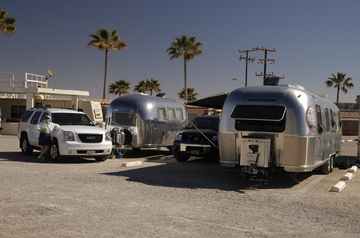
Our campsite next to Ken & Petey at Playa de Oro
Google Earth location of Playa de Oro campground.
There are several RV parks right along the beach, and we’re in one of them: Playa de Oro. This place is located south of the Old Port, near a lot of tourist “restaurant-bar” spots (emphasis on BAR, especially this month). The park is 320 tightly spaced full-hookup sites on a crushed shell surface and no view except on the beachfront sites. At night the restaurant-BARs turn on their music and we get a free, somewhat muffled, concert of dance music until about 2:30 a.m. Last night it was noisy but not unbearable, and we managed to sleep through it.
We don’t know if the water in this campground is safe to drink, but we arrived with a full tank (39 gallons) of fresh water and it should last for the four days we will be here, with conservation. If not, a vendor drives by daily in a pickup truck loaded with 5-gallon jugs of agua purificada, and when he honks his horn all we need to do is wave to him and buy a jug, just like we would for an ice cream truck. As a result, we have not connected to the water spigot at our site.
Similarly, we have avoided using the AC power. I tested the power outlet for correct wiring (ground, polarity, hot/neutral) using the simple tester that Airstream provides with every new trailer, and it passed. That’s more than I can say for some US parks, most recently one in New Mexico we stayed at. However, my voltage tester is dead, so I can’t verify whether the current is in the safe range for running certain appliances, like the air conditioner. Mexican campgrounds have a reputation for wildly fluctuating voltage, sometimes dropping during the day and rising at night, or spiking without warning.
As in other desert locations, there’s endless sunshine, so our strategy is to simply not plug in except for a few minutes in the morning to run the coffee pot. With the cool sea breezes we don’t need air conditioning anyway, and the solar panels are supplying more than enough power each day to fully replace what we use at night. My laptop, which comes out only once every other day to record my musings, is running off DC power and is thus insulated against variances in the AC voltage.
For the various comforts and liabilities listed above, we are paying $19 per night, which is very reasonable by US standards for a spot about 200 yards from the beach. In Fort Myers Beach, for comparison, a similar site cost $52 per night, although the beach was prettier. The beach is not bad here but certainly not up to the gorgeous sugar-white standard of the Florida barrier islands, and not quite as nice as the beaches north of town, which are wide, shallow, and uncrowded even during Spring Break.
The water is reasonably clear, if somewhat cold, and the beach is a coarse tan sand which at low tide reveals shelves of the underlying volcanic basalt. Anyone on the beach will soon encounter all types of beach vendors, selling “Cuban” cigars, jewelry, trinkets, and other assorted junk. Not one so far has offered us the stuff one might expect on the beach: cold drinks, sunscreen, parasols, folding chairs, inflatable beach toys, or kites.
February 3, 2007 at 8:19 pm · Filed under Places to go
The observatory was great last night, until the full moon rose and obliterated the darker objects in the sky. Emma saw the a few bright stars, the Andromeda Galaxy, the Orion Nebula, and a star cluster. With a Meade LX-200 telescope, you can really get a nice view. Check out the Butterfield RV Resort in Benson AZ if you want to try the telescope some time.
Of course it was a homeschooling event as well. Emma didn’t really appreciate how far away or how large stars were. It was fun to show her a blue giant star and explain that the light we were seeing has been traveling for 1400 years to get to our eyes. We also talked about how nebulas are giant clouds of gas in which stars are born, a concept that Emma seemed to find fascinating. Of course, a six-year-old’s grasp of these things is pretty limited, but at least we’ve gotten a start.
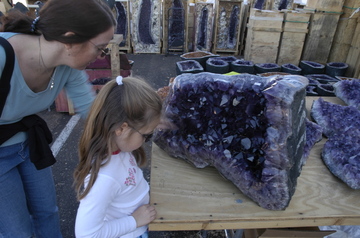
A few geodes at the Tucson Gem and Mineral Show
Today we moved about fifty miles to Tucson and set up at Beaudry’s. Our Google Earth location. There are at least three other Airstreams here, and hopefully we’ll meet up with some of their owners on Sunday. But today we headed straight out to one of the many Gem & Mineral Show venues to look at more rocks.
Emma spent most of her time watching the ground. Lots of fragments end up discarded on the ground, and nobody seems to mind if she picks them up. So I ended up with a pocket of a wild variety of small stones collected by Emma: opalite, lapis lazuli, goldstone, “sleeping beauty” turquoise, black opal, fire citrine, green catseye, and several other interesting bits we can’t yet identify. None are larger than 1/2″, and some are just tiny chips.
The nice thing about the show is that every venue is different, with all kinds of interesting stuff — not just rocks. Jewelry, crafts, beads, food, Indian art, leather, tools, etc. The other nice thing is that admission and parking are free. We saw just one venue today, so there’s a lot more for the next few days.
Book report: Dr C sent me a copy of “On The Border” by Tom Miller, which I finished last week. It’s a great series of vignettes of real life in the Mexican border zone in 1980s. Miller argues that the border is functionally its own country, with unique laws, rules, customs, and problems, and he documents it beautifully in stories both funny and sad. Although the book is a little dated now, my experience with the border suggests that things haven’t changed much since 1985.
Miller couldn’t foresee the massive increase in border paranoia that would come. Concern over drugs, terrorism, and “UDAs” has made the border more tense, more complex. But the book is still good reading if, like us, you spend time in this unique territory.
February 1, 2007 at 6:16 pm · Filed under Places to go
It’s a good thing we went rockhounding yesterday and didn’t wait for today. The wind is blowing so hard and cold we can barely stay out for a few minutes. The national weather service says it is gusting occasionally to 40 MPH but it seems like 40 is the rule rather than the exception. Just opening the door of the trailer is an effort against the wind. I should have put the stabilizers down when we arrived, because the wind is hitting us broadside and making the trailer rock like a cross-country train. But now it’s cold and I’m comfortable in here, so we’ll just enjoy the ride.
Days like this make me feel almost guilty for being so comfortable in the Airstream. There are couple of intrepid rockhounds in a tent nearby, and their tent has been battered all day but is somehow still standing. They have to be freezing — the wind chill is about 27 degrees. Meanwhile, we are living cozily. I have been working on the bed all day with the furnace purring. Eleanor and Emma have been homeschooling and working on bead art projects. At lunchtime we took a short hike down the road, paid for another night of camping, and let the wind blow us back to the trailer for hot lunch and root beer.
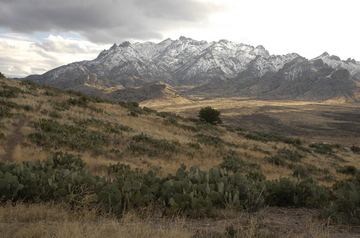
Rockhound State Park is a beautiful spot. The campground is not much to look at, although it is in good condition. But the setting is marvelous. To the southeast we have craggy peaks covered in a light snow. To the north, the hill rises from the campground to expose ledges of rock filled with jasper. To the southwest, flat open ground is criss-crossed with the streets of Deming, and the sun beams down through gaps in the clouds to illuminate the desert in gold. Far south, we can see another range of mountains in Mexico. The visibility today has fluctuated but at times it is incredible — probably 75 miles.
At night the air is so clear that the lights of little Deming (5-9 miles away and 1,000 feet below us) glisten like they’ve been polished. It looked like a miniature Los Angeles last night in the full moon. If the wind doesn’t blow me to Las Cruces, I’ll break out the tripod and try to get a night shot.
We have discovered the identify of two of our rocks: red jasper and yellow jasper. The yellow is particularly beautiful. We’ll ship it home to Papa to see if he can polish it up.
We have also solved another mystery: the amazing refrigerator smell. A week or so ago, we noticed that everytime the fridge was opened, an incredible odor rolled out. This odor, reminiscent of bad meat mixed with garlic, was so intense that we’d immediately want to open the windows no matter how cold it was.
Last night I had had enough, and emptied out the refrigerator in search of the culprit. I found nothing except some jars of mustard and black bean sauce that had some slight odor to them. But this morning Eleanor found it: the darned stinky cheeses we bought back in Austin! That Cowgirl “Red Hawk” cheese is really powerful. Mixed with a little gorgonzola it can find its way through a sealed plastic bag.
The offending cheese has since been double-sealed in bags and the smell is — thankfully — gone. You may find it amazing that we’d eat something that smells so bad, but it tastes better than it smells. I guess it would have to …
January 30, 2007 at 7:56 pm · Filed under Places to go
Below a gray sky we bid adieu to the RV park, checked the post office one last time for any late packages, and towed the Airstream seven miles from our base elevation of 3,600 feet to the entrance to Carlsbad Caverns National Park at 4,400 feet.
The Visitor Center and cave were virtually abandoned, which is not surprising considering the abysmal weather. All the winter tourists seem to be fleeing for warmer spots, which strikes me as an excellent plan except that there aren’t any warm spots outside of southern Florida and Mexico. We had no trouble parking all 50 feet of Airstream & truck in the lot. The cave was so deserted that we walked for over 30 minutes before encountering another person.
We hiked down the Natural Entrance, which is about a mile and 850 feet of descent. This hike is strenuously cautioned by the park service. “Evalute your physical condition before attempting this walk!” “Weak knees are common!” Huh. It’s a walk downhill on a paved trail with handrails. Last time Eleanor did it seven months pregnant.
Our National Parks pass got us in for free. Except now it’s the “America the Beautiful National Parks and Federal Recreation Lands Pass,” and now it costs $80 instead of $50. They’ve dropped the $15 eagle hologram, too. This new pass basically covers every Federal site that charges admission (but it doesn’t cover camping fees or added-value tours). We got this latest pass in Vicksburg when our National Parks pass expired, and using it today saved us $18, so we’ve got a few parks to go before it pays off.
The cave is supposed to be a constant 56 degrees, but in winter the cold air above settles into the cave and causes a constant breeze at certain points on the Natural Entrance hike. Since today the temperature at the entrance was 29 degrees (with fog), we had a chilly hike in.
Still, the cave is magnificent and amazing for both its natural features and the incongruous man-made ones. This is confusing for Emma, who at one point marveled at the huge open space replete with hanging stalactites and said, “I cannot believe this is not man-made!” This is from a child who has visited numerous large caves and lava tubes and who can readily identify cave draperies, popcorn, soda straws, and “bacon.”
Carlsbad is a park from the old school, so it features things you won’t see in other parks from a more enlightened era. For example, at Kartchner Caverns State Park in Arizona, they are so concerned with protecting the natural condition of the cave that visitors are sprayed with a fine mist to remove dust, and walked through several air-tight doors to control humidity. At Carlsbad, they have a restaurant in the cave.

Stamps in our National Parks Passport
The restaurant was built in 1928, and not surprisingly the bathrooms directly adjacent arrived shortly after. There’s also a mailbox, so you can post a letter from below the Earth’s surface. In fact, you can do quite a bit of shopping underground if you care to. After an hour of hiking we stopped in for a snack and asked Emma if she wanted to see more cave, or ride the elevator up and out. “More cave!” So we hiked the entire Big Room tour too, for a total of about 2.5 miles.
Considering that it was a totally dismal day, hiking underground beat the other options available. I had hoped for clearing by the time we emerged, but at 1 pm it was still very cold and cloudy, and we high-tailed it for the south. Along the route (Rt 62/180 to be specific) you have to climb up to 5,695 feet in the Guadalupe Mountains. Up there it was dense fog, temperatures in the upper 20’s and windy. I had to drive carefully, constantly on the lookout for ice on the road, until we descended back down before 5,000 feet.
We are covering a lot of miles in order to have time to explore some things in New Mexico and Arizona before we have to fly out. So we have stopped for the night in Las Cruces, boondocking in the retail center while we consider our options. We may stay here a few days (in which case we’ll get a campground) or move on, depending on how things look.
January 10, 2007 at 6:21 pm · Filed under Places to go
Emma had a rough night, so we let her sleep in today. Some nightmares … probably the result of not burning off enough energy during the day. That put us behind schedule today, so we stayed back in the trailer during the morning and met Jody and Joe for lunch at the Faculty Club.
And thus the Tour Of Ruston began! First stop was the Exploratorium at the university, which is a small but packed hands-on science museum for kids. Emma learned about how tornadoes form, played with some pendulums, handled some rocks she hadn’t seen before, etc., so that helped us do the science homeschooling for the day.
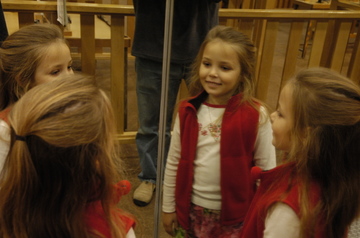
At one point it seemed we had four children
Next stop was Hart Associates, a custom lighting manufacturer. Jody has been enthusiastic about these folks for a long time, and with good reason. They make some fine stuff and absolutely everything is made to order. Consequently, they are high end and worth it.
We got a full factory tour by Sandra Grady Hart, who is half of the husband-and-wife team that runs the place. They seem to be able to make a lamp out of any material, in any size, with a wide range of designs that they develop right there, and put on any finish you might dream of.
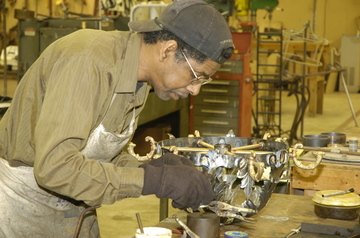
From there we were guided by Gary McKenney, the General Manager of the local radio stations. He took us over to meet Ruston Mayor Dan Hollingsworth. The Mayor is a nice guy — proven by the fact that for many years he and his wife took their five children Airstreaming! We had a nice conversation in his office. He asked about Emma’s homeschooling. It turns out he’s really concerned about kids learning to read, and thinks (as I do) that it’s the most fundamental and important skill they’ll learn.
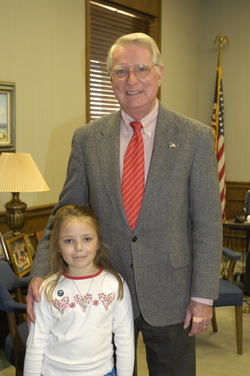
Done? Not hardly. We zipped over to Libby and Andy Follette’s pottery store along I-20, and then over to their shop on Pea Ridge to see Andy making some of the pottery.
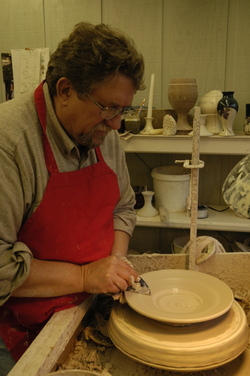
Andy demonstrates making a plate
Like Hart Associates, we got the full tour, including a peek into a kiln to see finished products coming out. Each piece is a little different, so it’s a bit like watching a birthing.
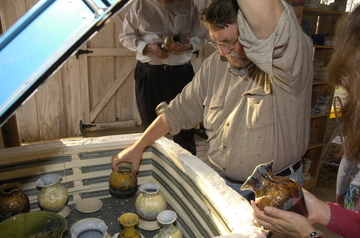
The peach trees here aren’t doing much this time of year, but the peach store at Mitcham Farms is still open. So Gary took us over there, too, and we just caught Jim Mitcham as he was about to leave. Apparently in June peaches are a huge thing here, with a massive festival that has been held for about 50 years. Peaches are a very perishable crop, so they don’t ship like apples or oranges. If you want the really, really, fresh peaches, you have to come here in June and eat ’em right away.
Yeah, it’s hot and humid in June. But I bet the peaches are worth it. Since it’s January, we’ll just taste the peach jam and peach salsa that they sell in the off season, and think about those fresh peaches …
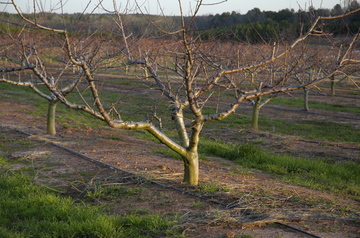
A dormant peach orchard
If you think that was a lot, there’s more coming tomorrow. We’re scheduled to present at the country club tomorrow after lunch. I’ve recruited Eleanor to co-present and supply the “woman’s perspective” since the audience will be mostly women. Then we hope to meet up with Scott Terry — the guy who wrote us the funny letter — and go see the Bonnie & Clyde stuff.
January 9, 2007 at 10:49 pm · Filed under Places to go
Not having done any real research for the day’s route, we didn’t know much about Vicksburg National Military Park before we arrived. It is a drive-through park, with a convoluted 16 mile road that rolls up and down the hills that gave the Confederate Army the high ground as they attempted to defend a stretch of the Mississippi River.
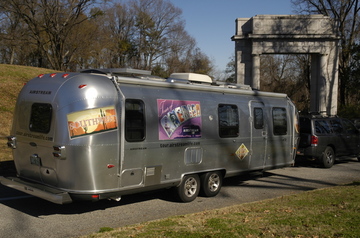
Dotted along the road are monuments, earth fortifications, cannons, and interpretive signs. It’s the kind of place where you can spend any amount of time you want, depending on your interest. Despite the roads many twists, it was easily traveled by our 30-foot Airstream, and parking along the road was easy since hardly anyone was visiting today.
A highlight of this road is the ironclad gunboat “Cairo”, the remains of which were rescued from the bottom of the Yazoo River after 100 years. It is now on permanent exhibit under cover, and a museum of its artifacts is nearby. The Cairo was one of seven magnificent boats of the “Inland Navy” created by the Union specifically for the Civil War. Covered in charcoal iron plating 2.5 inches thick, it boasted 75 tons of armor.
But the Confederates found the Achilles Heel of the ironclad, and exploited it by detonating a floating mine which mortally wounded the Cairo. With its port hull ripped open, the Cairo sank in 12 short minutes … but miraculously all 175 crew survived.
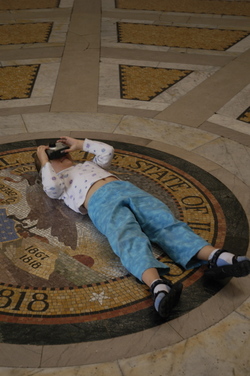
Emma snaps a photo of the ceiling
Vicksburg NMP is not the sort of place that Emma finds interesting. She had never heard of the Civil War, and at age 6 her ability to comprehend it was limited. This meant a short visit before heading onward to Ruston.
Before we left Vicksburg, we took a short driving tour of the downtown and riverfront area. Four floating casinos have been established along the riverfront, but their impact on the rest of the city is not visible. Given the depressed nature of much of the town, I’m not sure that’s a good thing.
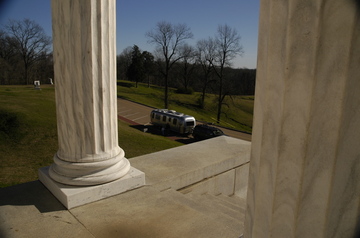
We’re established in Lincoln Parish Park now. This is a nice spot by a lake, with full-hookup sites. It’s one of those places you might easily miss, but at least from our view before the sun set this evening, it’s very pretty and (this time of year) not very crowded.
This evening we had dinner with Jody and Joe, who are responsible for our being here. They have revealed that we will have a full day tomorrow of red-carpet treatment courtesy of the people of Ruston. What that means exactly remains to be seen.
January 7, 2007 at 11:00 pm · Filed under Places to go
The flamingos were out this morning in a large flock!

Photo by Devoman
But I slept in … and so did Emma, worn out from a big day of cycling on Saturday. I showed up for “breakfast” at site 164 around 9:00.
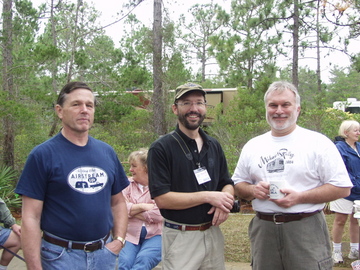
Herb, Rich, and Joe out for breakfast under the pines
The rally was supposed to end today, but it turned out that many of us were staying an extra night or more. By afternoon I counted 15 Airstreams still here, including Carol, Joe, Steve & family, and Wendimere & Bill.
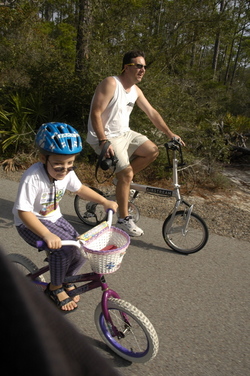
Bill and Emma race to the beach
We decided to stay one more night. Taking an extra day turned out to be the right move, despite the high cost of this campground ($42 with tax). Instead of rushing out after the rally festivities, we got a chance to relax and enjoy a much less hectic day. Since we got a fairly nice day with temps in the 70s, I was also able to let the awning dry out before rolling it up. We’ve had rain every night and heavy dew as well, so drying things has been tough.
Emma took me, Joe, and Bill out for a bike ride to the beach, which is about a mile down a paved road. The sea was rough, as it has been every day since we arrived in the panhandle. The storms that keep passing through are really stirring up the water, so the “Emerald Coast” is more of a murky green.
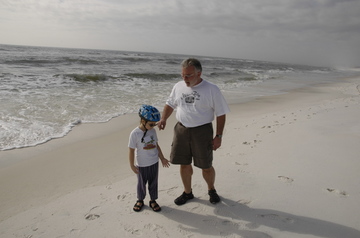
On the way back, Emma organized a race. We took it easy because she still crashes regularly. Today she clipped the edge of the beach tram and landed in a big puddle, but got up feeling fine. So far she’s had about six spectacular crashes but no injuries. Everyone in the campground knows her now, either because she’s crashed on their lawn or ridden by screaming “Woo-hoo!”
This evening we had an “impromptu pot luck” which most consisted of leftovers of last night’s huge dinner — and it was good — and then at 7:30 we showed Superman 3 on our big screen for seven adults: Carol, me, Eleanor, Wendimere, Bill, Steve, and Misty. The kids watched “Cars” on Emma’s little DVD player in her bedroom. So yes, with a little creativity we can actually get seven people in position to watch a movie in here.
Tomorrow we will pack up and hit the road. Our date in Ruston is looming, and we need to cover 488 miles on Monday and Tuesday. We have no planned stop between here and there, but a few ideas and we’ll just see how things go …
« Previous entries ·
Next entries »



















